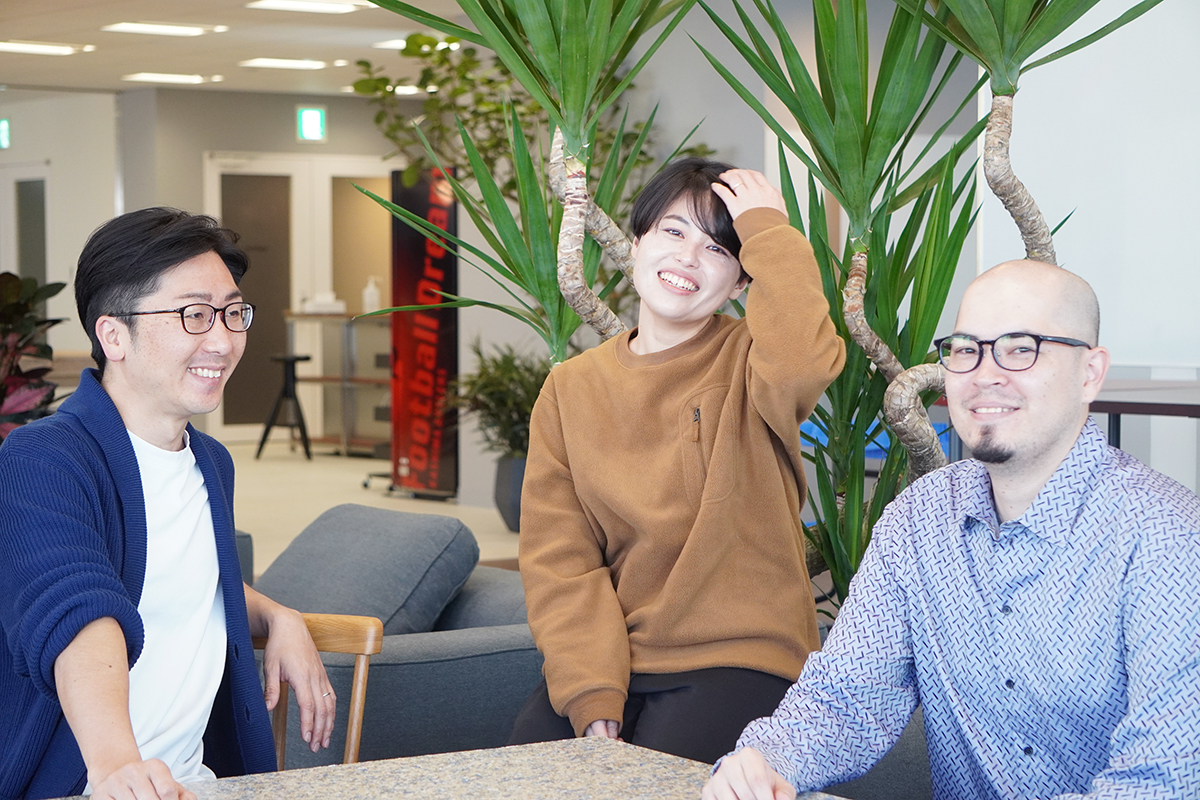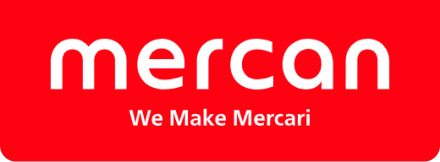
2023-3-7
Encouraging Sustainable Actions With Mercard: The Story Behind Mercari’s New Credit Card and the Experience It Brings to Users
Now that Merpay is five years old, the company is ready to take on new challenges and strategies in the fintech domain. The product at the very core of this endeavor is Mercard. Launched in November of last year, Mercard is Mercari’s first-ever credit card, which has been carefully designed and tailored to match the lifestyles and values of its users. The card features thoughtful details such as being numberless, using recycled materials, and having a simple design that suits various people and situations. It is a timeless yet modern credit card that also embodies Mercari’s goal of realizing a circular economy.
Another key feature of Mercard is the point-back rewards system. The point-back rate for card holders is determined based on their usage of Mercari and Merpay, and this point-back rate goes up whenever they make payments at stores or use Mercari and Merpay. Today, we are getting a behind-the-scenes look at the discussions and decision-making processes that went into creating and releasing this card out into the world. We sat down with Masato Yamamoto (CEO of Merpay / CEO of Fintech, Mercari), Mayumi Narisawa (CPO of Merpay), and Jeff LeBeau (CEO of Marketplace, Mercari), who spoke at the Mercari Fintech Business Strategy Presentation 2022 on November 8 of last year. In our conversation, we asked them about the story behind Mercard and their vision for expanding the Mercari experience through this new product.
Note: This article is part of an ongoing series published on the Mercari Engineering Blog titled “Mercard Behind the Scenes.”
Featured in this article
-

Masato YamamotoMasato completed his master’s in the Graduate School of Interdisciplinary Information Studies at the University of Tokyo in 2004. After working at NTT Docomo, he began working as the Head of Partner Sales in the Enterprise Division at Google Japan in 2008. In 2014, he became the Head of Business Development and Sales at Square Japan, and in 2016, he became the Head of Apple Pay Merchant Business at Apple Japan. He joined Merpay as CBO in April 2018, where he oversaw general business operations, such as credit design and merchant development. In January 2022, he assumed the role of Merpay CEO. He was later appointed a VP for Mercari and joined Mercoin’s Board of Directors in July 2022. -

Mayumi NarisawaAfter graduating from music college, Mayumi found herself moving into the IT field through a music education business she was involved in. She worked on the service design and UI/UX design of numerous mobile service providers at DeNA Co., Ltd., and then moved to Kyash Inc., where she was in charge of experience design for its physical card. She joined Merpay in 2018 as a Product Designer and took on the role of UX Lead, optimizing the Merpay screen whenever a new feature was introduced. She has helped lead the company from the time of its inception to its current phase of growth. After spending some time as Head of Design, Mayumi was appointed as CPO of Merpay in January 2022. -

Jeff LeBeauAfter graduating with a BSc in Economics from the University of Oregon, USA, Jeff worked as a freelancer in localization and development of global expansion strategies for web services. From 2014 onward, he worked with venture and mega-venture companies in both Tokyo and Silicon Valley. He joined Mercari US as Business Operations Manager in June 2017 and transferred to Mercari JP the following year to work on developing data-driven business strategies. Jeff was appointed Vice President of Analytics in 2020 and assumed the position of CEO of Mercari Japan in January 2022. He has been in his current position since July 2022.
A one-of-a-kind card that encourages sustainable actions
──First off, now that you’ve made the announcement at the Mercari Fintech Business Strategy Presentation. How are you all feeling?
@jeff:It’s been a while since we’ve launched a major product like Mercard. The response was positive when we announced it internally, but after making the official announcement, it was nice to see so many members ready and excited for the launch.
There was also great feedback from outside the company. I’ve already seen people saying they can’t wait for it to come out or that they’re definitely going to get the card, which makes me genuinely happy. It does not end here, though. For example, we’re about to start discussions on how to further enhance the point-back system, so I’m looking forward to finding more ways to evolve the product.
 Jeff LeBeau(@jeff)
Jeff LeBeau(@jeff)
@mark:The main purpose of the business strategy presentation is of course to make public announcements to people outside the company, but I’ve always thought of this presentation also as something directed at everyone working at Mercari Group. It was an intentional decision to have Jeff speak at the fintech business strategy presentation, because I wanted to make sure it is clear that the strategies shared are not just limited to the fintech business—they impact and involve the entire Group. Based on the response we got from the media, I was glad to see that this message seemed to get across. People understood that we are working on these initiatives not just as Merpay, but as Mercari Group as a whole.
Another thing that I thought was really reflective of Mercari’s culture is that former members who have already left the company were also tuned in and sharing their thoughts on social media. This project was a huge undertaking that involved many different parties, but it was nice to also get support from people who were not directly involved.
@narico:It was indeed a major undertaking, as we spent about two years preparing to launch the service. For the people involved in development, two years is a very long time to spend preparing for a new business. I think many members were eager to release the service to our users, and the business strategy presentation was the day that this wish finally came true. In that sense, I wanted to make it a satisfying presentation that made them feel that the time and energy spent was well worth it. I wanted the members involved to feel a sense of accomplishment, like “I was a part of something special—this project was something I could have only accomplished at Mercari/Merpay.” In particular, Mark and I spent a lot of time with the PR Team figuring out how to communicate the uniqueness of the product, making last-minute changes until right before the announcement. I think these discussions paid off, since there was a lot of excitement among members from both our fintech and marketplace businesses.
After the presentation, I feel strongly that Mercard is the long-awaited product that connects the entire Group. Whether it was designing the card or coming up with the point-back system, we never lost sight of the end goal and what we ultimately wanted to accomplish. Under the shared goal of the successful launch of Mercard, we were able to unite the marketplace business and Merpay as one.
@jeff:Speaking on behalf of Marketplace, our next focus will be finding ways to improve the point-back system, as well as how to get more users to use Mercard to pay for things on the Mercari marketplace. So, there is still lots more work to do! (laughs)
──I’d like to talk more about the benefits for users. What kind of advantages or new experiences do you want to provide to people through Mercard?
@Jeff:Our goal is to contribute to creating a circular economy by making it fun for people to buy and sell on Mercari, and I think Mercard gets us closer to achieving this goal. With Mercard, users can get points back whenever they use Mercari or Merpay. The point-back rate is determined based on their usage of Mercari and Merpay, with a maximum of 4% when using Mercard or Merpay’s deferred payment service and a flat rate of 1% for purchases made outside Mercari. Whether people buy something at a store or complete a transaction on Mercari, their point-back rate will go up. The act of buying and selling on Mercari has always had a positive impact on the environment, but users will now also be rewarded with points. It is a card that encourages sustainable actions instead of just consumption, which is a unique experience that only Mercari can provide.

@narico:The credit system also sets Mercari apart. The upper borrowing limit is not decided based on people’s age or occupation like other cards, but based on their usage of Mercari. For example, a user’s credit can go up through completing polite and careful transactions. This means that we will be able to provide credit to people with attributes that made it difficult for them to receive credit approval from other companies. There is also great flexibility in how you pay for things. Not only are you able to select your preferred withdrawal date, if an item sells for a higher price than you expected and you have a little extra in your Mercari sales balance, you can also use that portion to settle part of your credit card bill before the payment deadline.

Offering new experiences with a positive social impact
──During the few years working on this project, what discussions or decisions took the most amount of time?
@mark:The basic framework for Mercard was decided pretty quickly, but we spent the most amount of time figuring out how to design the point-back system. Discussions about this kind of thing tend to center around how to give people the most amount of points, but we didn’t want that to be the primary focus. Mercari has always pursued new ideas without getting caught up in what other companies are doing, and I wanted this to be the case with our point-back system. It was important to ask ourselves, “what makes Mercari unique?” and “what is the type of value that only Mercari can provide?”
Right around this time, an ESG Committee was established within the company. In recent years, there has been a greater emphasis on the importance of sustainability and the circular economy, and companies are also being asked to do more in this regard. As part of the committee, Shin (Mercari Representative Director and CEO) suggested our team position these environmental topics at the core of Mercard’s point-back system. It is common for companies to use points as a way to keep users in their ecosystem and use their services as much as possible. However, Shin’s advice prompted us to focus our messaging on sustainability—rather than just rewarding the act of purchasing things, we can reward people for making a positive impact on society. If we give users points for acting sustainably, we thought it would naturally lead to people engaging in more sustainable behavior overall.
The idea for people’s point-back rates to go up the more they use Mercari and Merpay was there from the very beginning. However, through discussions, we made the conscious decision not to disclose the specific actions that would trigger this increase. This is because we wanted people to keep using Mercari like they always have, and for the increase to happen naturally. If we released the specific conditions for people’s point-back rates to go up, we were afraid people would start feeling like “I should do this” or “I should do that.” It would take away the fun from our app. I think most other reward programs are designed with about four levels. With Mercard, we have broken it down into more micro levels, so our users can enjoy a boost in their point-back rate even with small actions.
 Masato Yamamoto(@mark)
Masato Yamamoto(@mark)
@jeff:One big reason for integrating both Mercard and the point-back system into the Mercari app was to make it easier for users to access and use these new features. Rather than hurting or complicating the existing UX, we thought this addition would actually improve the overall Mercari experience. In general, we designed the system so that if you are a Mercari user, it makes sense to use Mercard. The next step will be figuring out a simple and natural way to communicate this message to users and have them understand the benefits.
Carefully designed to match the lifestyles and values of our users
──Earlier, you touched on the physical design of the card. Could you tell us a little bit more about the concept behind the design and the considerations that went into it?
@narico:The concept of Mercard is for it to match the lifestyles and values of our users. The surface of the card is simple with minimal colors and text to match any wallet and occasion. Even with the logo, we decided to break away from our usual corporate colors of red and blue, and instead designed a holographic logo that changes color depending on the angle, reflecting our intention for it to be a card for everyone. Mark spoke about incorporating the topic of sustainability into the point-back system, but this is also something we did for the card design. Mercard is an eco-friendly credit card that uses over 85% recycled plastic materials, which means that it causes less harm to the environment compared to the conventional card manufacturing process.
Speaking of the simple design, one of the major decisions was making the card numberless. The card number can be easily found on the Mercari app, and removing it from the actual card makes payments more safe and secure. If you ever lose your card or it gets stolen, you can also immediately cancel the card from your mobile device.
For me, the keyword of this design is “upgrade.” I view Mercard as the third chapter for Mercari. The first chapter was Mercari as the marketplace app. The second chapter began about five years later, when Merpay was launched and allowed users to do more with their Mercari sales balance. For the third chapter, I thought it was necessary to come up with an upgrade—to develop something that would take Mercari and Merpay to the next level.
In that sense, I think the point-back system has achieved this. It is a revolutionary upgrade that will offer an all-new Mercari experience. However, the tricky part about creating something new is making sure we are not trying to fix things that are not broken. For example, with this new chapter, we wanted to ensure that existing users can hold onto their habits and continue using Mercari the way they like. We were also careful not to make the experience worse for everyone by trying to cater to too many kinds of people—by making changes to please everyone, we may end up pleasing no one.
This third chapter is new while still feeling familiar. Mercard’s point-back rate will keep going up as long as people continue using Mercari the way they always have been. They do not need to make any big changes in order to enjoy this new experience. These aspects of familiarity were important while developing the product within the app, and they were also considered when designing the physical card. For instance, when designing the surface of the card, we avoided highlighting our logo and brand too much so that the card feels natural and comfortable to use while shopping online or at stores. We were not focused on making sure people know that it is a Mercari card. Rather, we thought it was important to create an experience on the Mercari app where users feel like, “as long as I have this card, the possibilities are endless.” I think these thoughts are what led to Mercard’s simple design.
 Mayumi Narisawa(@narico)
Mayumi Narisawa(@narico)
──I guess if you got caught up in conventional card designs and other preconceived notions, you would not have ended up with this credit card.
@narico:That’s right. I was actually involved in developing a physical card that is linked to an app at my previous company, so going into the project, I had some biases and preconceived notions on what a credit card “should” look like. Our team decided to go with a simple and minimal design for Mercard so that the card doesn’t feel too different from what people are used to, and people can enjoy the experience of shopping just like before. At the same time, we wanted the design to still look like a credit card and include the necessary information to make card payments at stores. The project members spent a lot of time learning the systems that the card is linked to, while discussing each and every component to be added on the surface of the card. Ultimately, Mercard is a credit card for people who want to have more fun using Mercari, and this includes people who have never owned a credit card before. In our discussions, we stressed the need for the card to feel safe and easy for anyone to use, regardless of their prior experience with credit cards. For both big and small decisions, we were constantly thinking about Mercari’s existing users and their point of view.
@mark:We really discussed each and every aspect of the card, didn’t we? I found that the process of designing a physical product was also different from working on an app in that there were things that we could and couldn’t do based on the manufacturing process and costs. It required us to look into what would be possible technology-wise, while still being bold and creative with the experience and feel we want to provide to our users. It was a process of digging deep into both of these sides, and then finding the perfect point where our technology and ideas meet. I think we ended up with an awesome product with no compromises, and I can’t wait for it to be out in the world!
──すHearing about the overall process, it sounds like you were not comparing yourself to other credit cards at all.
@mark:This is because we do not view our value as being relative to others. It is not that we purposely tried to make something different from other credit cards. We worked on building Mercard while searching for value that is unique to Mercari, and as a result, we ended up with a product that is unlike any other.
@narico:I also think that our decisions were not based solely on logic and cold-hard facts. We had emotional conversations with the members working on development saying, “this would look cool!” or “it would just feel nice for these services to be integrated.” We had a shared vision for what we wanted our product to be and were committed to delivering it straight to our users. I think this commitment to the vision is what garnered support from around the company. Since this was such a large project involving many people, we tried to move things forward with momentum and speed. Now that the product is released, I feel that we were able to achieve everything that we envisioned.
At Mercari Group, we have designers at each company. They are usually working toward separate goals depending on the company, but with Mercard, we wanted to involve all of these designers from across the Group as much as possible. We knew this would mean more opinions and discussion topics, and at times, it may be difficult to reach a consensus. However, one day, a designer from the marketplace domain told me that Merpay has always been and should continue to be fearless, and that we should stick to what everyone at Merpay thinks is cool. This was really reassuring, and I would often think back to these words during the development process. I think this kind of support is what helped us push forward our vision until the very end.
@jeff: The first time I saw the design, not only did it look and feel Mercari, it felt like a unique card that stands out from others. I believe we were able to end up with this special design thanks to this fearless attitude during the design process.
──Another thing that I thought was interesting is how the entire application process takes place on the Mercari app from start to finish. It is super quick and simple, but I imagine there are also some people who are suspicious of technology that is too easy or convenient, in terms of safety. What do you think?
@mark:It depends on the technology, but I personally think the simplified process equals increased security. Up until now, the process for applying for a credit card required you to fill out an application on paper, make a copy of your driver’s license, and then mail them in together. It was also a hassle for the credit card company, since they had to take the paper application and input the information into their system. This manual process was the norm for a long time, and from a security standpoint, there was a higher risk of data being leaked. since more people were handling the information.
We decided to keep the entire application process within the Mercari app to lower the chances of information being accessed and leaked as much as possible. By having users apply for Mercard using just our app, it makes it easier for us to identify who is submitting the application. It also gets rid of the need for their information to be accessed by more systems and people than necessary. Keeping it all within our app allows us to exercise greater control and responsibility in the handling of user information.
Mercard aims to explore and unleash new ways of shopping
──In the future, there may be people who start using Mercari because of Mercard. How are you thinking of appealing to people who have never used Mercari before?
@jeff:Of course, we want to provide a new experience to the people who have never used Mercari as well. One important part of this will be to show them how the act of buying and selling on Mercari in and of itself is fun. For example, maybe by seeing the people around them use Mercari and seeing their point-back rate go up and up, they will be prompted to try using Mercari themselves. I want to create this kind of experience.
@mark: I would like to see Mercard become more than just a payment method for people. This is because the ecosystem that we mentioned earlier is most effective when people are using Mercari Group’s different services in combination. I am picturing a cycle where someone goes shopping, sells an item that they no longer need on Mercari, and then uses that sales balance to settle their Mercard purchases. This will allow us to provide the most value to our users.
With that being said, Mercari does not have to necessarily be the starting point of this cycle. That’s the exciting part—this cycle can start from anywhere! I think many people will discover Mercard through Mercari, but as you said, there may be more and more cases of the opposite in the future. Or, maybe some will even start as a Mercoin user.

I believe that one of the qualitative values offered by Mercari Group’s services is the feeling of joy and excitement. Our services are inherently fun to use, and users can discover these exciting experiences all around the app, whether it is the thrill of finding an unexpected item or having a pleasant conversation with a seller. It is the same with Mercard.
When people use Mercard, they will get real-time notifications and be notified regularly that their point-back rate has gone up. It is a very interactive design that can add some fun to their every day. These interactions will happen on the Mercari app, so naturally, there will also be more touchpoints between Mercari and users. I think in this way, we can create a future where Mercard is the starting point for people to enter the Mercari Group ecosystem. I want to keep creating experiences to make that future a reality!
──Lastly, what kind of possibilities are you looking to unleash with Mercard?
@narico:Right now, Mercari is trying to get involved with primary distribution, but we have so far been limited to communication that takes place on the app. It has been difficult getting people to buy and sell things offline, and there is also the fundamental issue that we are still way behind with data acquisition and analysis. I see Mercard as a big opportunity to solve these issues. Mercard is a product that will be a big part of people’s everyday lives. From the payment data, teams at Merpay can perform analysis to find out user attributes and demographics as well as what users are interested in.
@jeff: I would also like to form partnerships with people and businesses that have good synergy with Mercari. In the future, I think there will be more people who buy things with Mercard and then sell those things on Mercari. I want people to use Mercard not just for the points, but to be part of this circular ecosystem that we have created. In other words, Mercard is not just a credit card for making payments. It aims to unleash more possibilities and offer a richer shopping experience to users.



